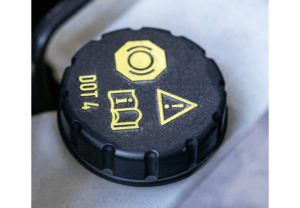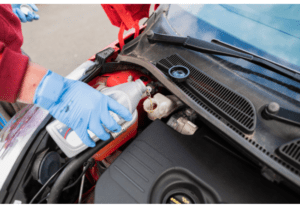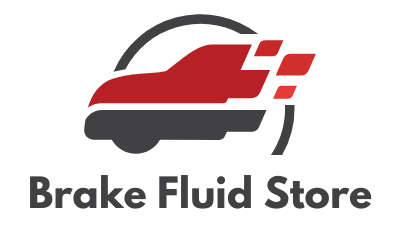The brake system of every vehicle is engineered precisely that allows you to stop your vehicle whenever needed. Other than different components, your vehicle’s brake system also needs brake fluid in order to work properly. Discover the difference between Dot 4 and Dot 5 brake fluid in the following article.
Unlike other fluids used in a vehicle, brake fluid is relatively straightforward and comes in a few different types. This article discusses all the differences between DOT 4 and DOT 5 brake fluids to help you understand the right brake fluid for your vehicle. So, let’s get into it.
Contents
What Are the Different Types of Brake Fluid?
What is Dot 4 Brake Fluid?

DOT (Department of Transport) 4 is one of the most commonly used types of brake fluid that’s based on glycol ether. It’s pretty similar to DOT 3 brake fluid but contains borate-ester additives.
It also offers higher wet and dry boiling points than DOT 3 brake fluid because of the addition of borate-ester. However, unlike DOT 3 the wet boiling point of DOT 4 falls quickly as it absorbs more water.
Brake fluid must have a wet boiling point of 311 degrees Fahrenheit or 155 degrees Celsius and a dry boiling point of 446 degrees Fahrenheit or 230 degrees Celsius in order to be classified as DOT 4.
It’s important to use this type of brake fluid only if it’s recommended by your vehicle’s manufacturer or preferred for your vehicle’s brake system. It means you should not use this brake fluid for upper or lower-grade vehicles.
In order to maintain the performance and safety of your vehicle’s brake system, you must change your DOT 4 fluid after every two to five years. DOT 4 is hygroscopic brake fluid and it absorbs moisture through hoses with the passage of time.
Therefore, it becomes less effective over time and starts overheating your brake system. This way, it can damage your vehicle’s brake system and that’s why it’s critical to change on time. The addition of moisture reduces the boiling point of the brake fluid and if you don’t change it in time, it’ll start corroding the rubber parts of your master cylinder and wheel cylinders.
If you’re using DOT 4 brake fluid, you can switch to DOT 3 but not the other way around. While DOT 3 and DOT 4 are intermixable, mixing them together isn’t advisable because it can degrade the overall performance of your brake system.
If you need to use DOT 3 or even DOT 5.1. Consider flushing your old brake fluid completely before adding another type of brake fluid to your brake system reservoir. The Dot 4 brake fluid offers the viscosity of 1800 at 40 degrees Fahrenheit.
What is DOT 5 Brake Fluid?
The DOT 5 comes with an entirely different chemical composition from DOT 4 brake fluid. Unlike DOT 4, DOT 3, and DOT 5.1, the DOT 5 is silicone-based brake fluid and it’s also very expensive as it offers high boiling points.
Brake fluid must have a wet boiling point of 356 degrees Fahrenheit or 180 degrees Celsius and a dry boiling point of 500 degrees Fahrenheit or 260 degrees Celsius in order to be classified as DOT 5. This brake fluid is ideal for a modern brake system that comes with small and thin rotors and produces a high amount of heat.
It’s also important to note that the DOT 5 brake fluid doesn’t absorb moisture and it also doesn’t react with your vehicle’s paint. While it can replace DOT 4 and DOT 3 brake fluids, you must not mix them with them as the mixture can damage your brake system components.
Being a silicone-based brake fluid, DOT 5 is also very difficult to bleed. However, once you have bled it properly, the new DOT 5 will offer better corrosion and rust resistance and will function properly for a longer period of time than DOT 4.
The DOT 5 can also work efficiently in high temperatures and offers the viscosity of 900 at 40 degrees Fahrenheit. Interestingly, it offers highly stable viscosity in extreme temperatures. Just like any other type of brake fluid, the DOT 5 also comes with some drawbacks that you need to keep in mind.
Disadvantages of Dot 5 Brake Fluid
One of the biggest disadvantages of this brake fluid is that it makes the brake pedal spongy and soft with time. That’s because it expands at high temperatures and its additives vaporize at moderate temperatures.
You can’t simply add DOT 5 brake fluid to any system that uses DOT 4 or any other glycol-based brake fluid. You’ll need to flush the old brake fluid multiple times and you’ll also need to replace the system’s seal and it also can’t work with anti-lock systems.
DOT 5 brake fluid starts to compress at 300 to 350 degrees Fahrenheit, unlike DOT 4 that begins to compress close to its boiling points.
So, What’s the Difference Between DOT 4 and DOT 5?
The biggest difference between the two brake fluids is their chemical composition. The DOT 4 is glycol-based and the DOT 5 is silicon-based. The DOT 4 brake fluid is also hygroscopic whereas the DOT 5 brake fluid doesn’t absorb water but offers less viscosity.
Because of different chemical compositions, these two brake fluids are incompatible with each other, which means it’s not possible to mix them. Mixing them together can lead to brake failure.
The DOT 5 brake fluid was developed for the areas where moisture is a certain factor like military applications. It also offers higher wet and dry boiling points than DOT 4 fluid and offers a longer shelf-life.
DOT 4 Vs DOT 5: Comparison Chart
| Properties | DOT 4 | DOT 5 |
| Meets Specifications of | FMVSS 116, SAE J1704, ISO 4925, Class 4 | FMVSS 116, SAE J 1705, ISO 4925, Class 5 |
| Colors | Colorless to amber | Purple |
| Boiling Capacity | The dry boiling capacity is excellent but the wet boiling capacity isn’t great | Offers the best wet and dry boiling capacity |
| Chemical Structure | A hygroscopic mixture of glycol ether and borate ester | A hydrophobic blended mixture of tributyl phosphate and polydimethylsiloxane |
| Dry Boiling Points | 446 degrees Fahrenheit or 230 degrees Celsius | 500 degrees Fahrenheit or 260 degrees Celsius |
| Wet Boiling Points | 311 degrees Fahrenheit or 155 degrees Celsius | 356 degrees Fahrenheit or 180 degrees Celsius |
| Price | Can vary but generally ranges from $15 to $19. | Can vary but generally ranges from $18 and $45. |
Dot 4 is a more commonly used type of brake fluid as compared to DOT 5. It also comes with a cheaper price tag and is used as a standard option in many average domestic cars.
DOT 4 is compatible with anti-lock and traction control braking systems and many racing and police cars also use it. On the other hand, the DOT 5 can’t be used with anti-lock brake systems and it’s commonly used in high-performance racing cars and military vehicles.
Although DOT 5 Brake fluid comes with high boiling points and performs well in extreme temperatures. It’s more compressible than the DOT 4 and any other type of brake fluid that’s based on glycol ether.
In fact, there are some modern DOT 4 brake fluids available that even offer higher boiling points than the DOT 5 brake fluid. So, it’s not advisable to switch to DOT 5 if you use DOT 4 brake fluid for your vehicle.
DOT 4 Vs DOT 5 Brake Fluids: Brake Fade
You’d already know that brake fluid operates under extremely high temperatures and pressures. These extreme conditions can boil the brake fluid that can lead to brake fluid gas in your vehicle’s brake lines.
This brake fluid gas is compressible and causes a spongy brake pedal and this effect is called brake fade. As mentioned earlier, the DOT 5 brake fluid is more compressible. Which means that the chances of ending up with a spongy brake pedal with DOT 5 are higher than DOT 4 brake fluid.
This problem is less prevalent in domestic vehicles as they usually use DOT 4 or other glycol-based brake fluids but it’s relatively more common in vehicles using DOT 5.
What Happens If You Mix DOT 4 and DOT 5 Brake Fluids?

Mixing DOT 4 and DOT 5 brake fluid can result in a completely unresponsive brake system. That’s because of their different chemical composition and they can’t be mixed together. You’ll end up with a sludgy and thick fluid that will not work as desired.
Additionally, if your vehicle isn’t designed for DOT 5 brake fluid and you try to use it even after a full flush. You might still end up with a problematic brake system.
Final Words
Even though the DOT 5 brake fluids look a better option for your vehicle by looking at its numbers. But it’s most probably not the right type of an average vehicle because it’s designed for high-performance and military-grade vehicles.
So, if you’re not sure, refer to your manufacturer’s manual. It’s the best way to find out the right brake fluid for your vehicle.
